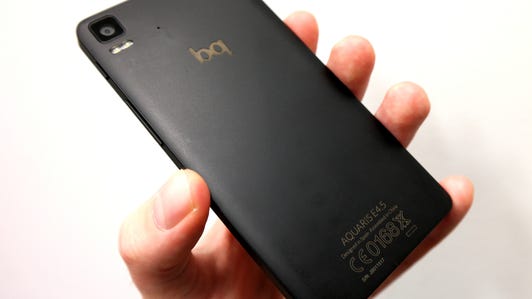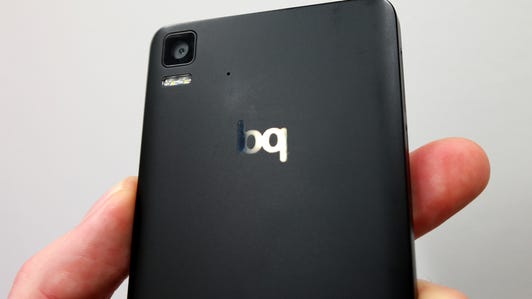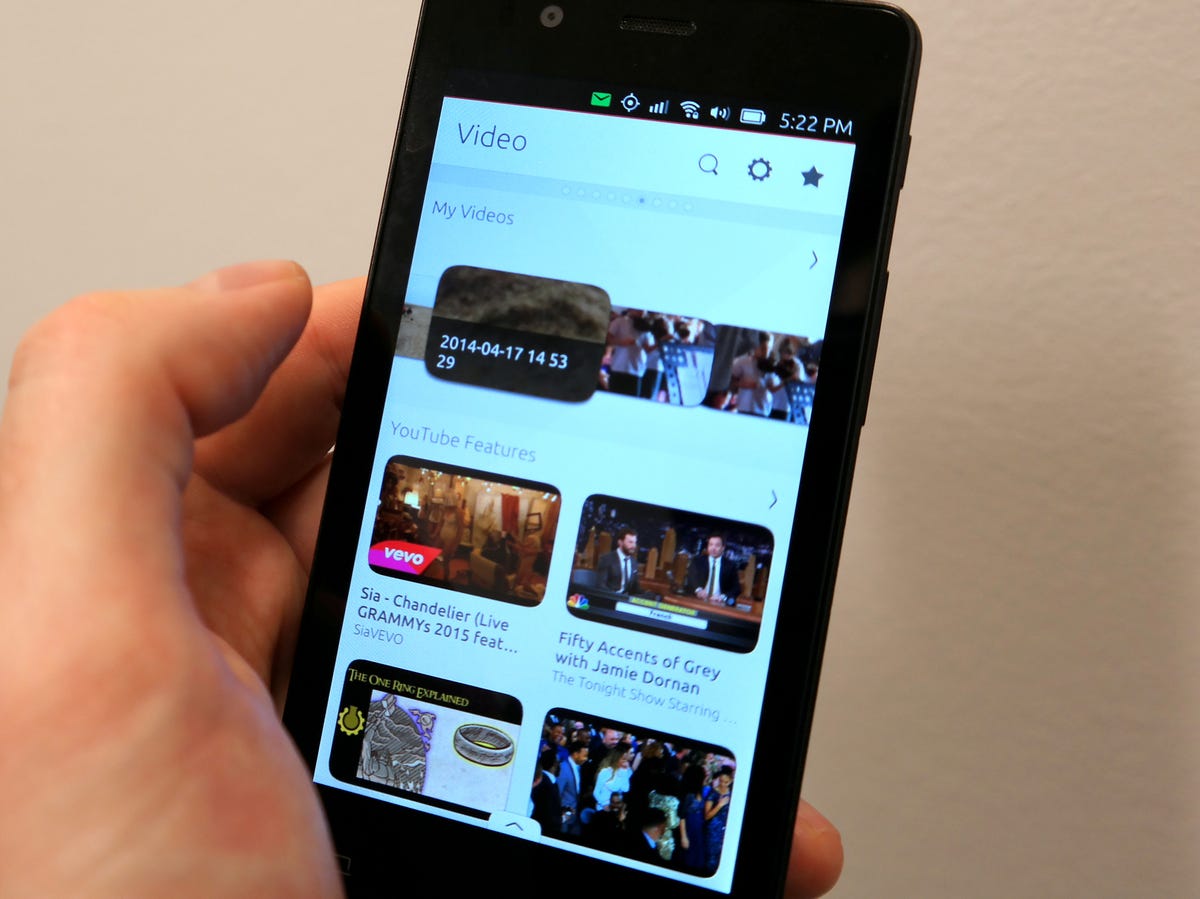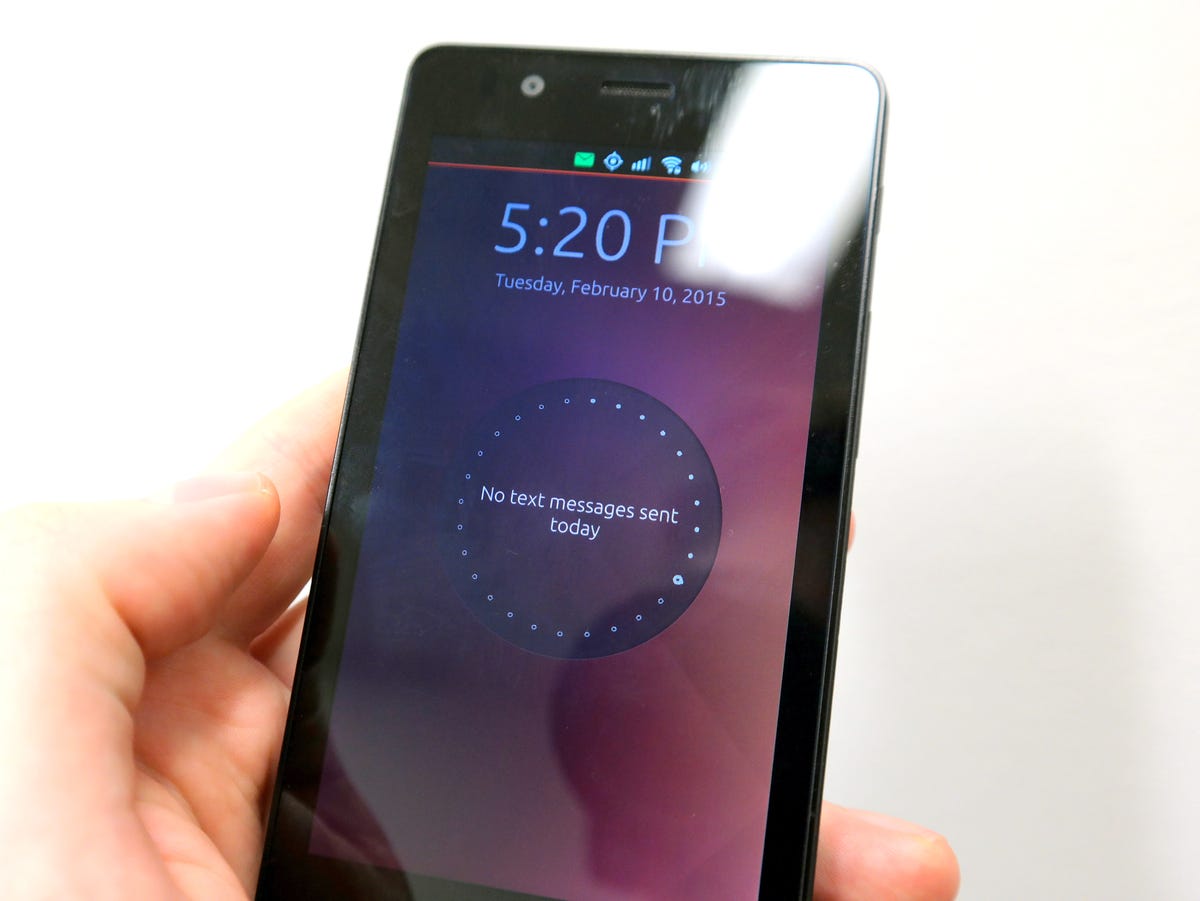
Rich Trenholm/CNET
The smartphone market has been a two-horse race almost from day one. But Apple and Google may have had their own way for too long, and many of the industry’s biggest players are looking for an alternative to Google’s Android mobile operating system. One possible alternative is Ubuntu, which is making the leap from PCs to phones this year. So what makes Ubuntu different to Tizen, Sailfish and the rest? I caught up with Cristian Parrino, VP Mobile at Canonical, to find out what Ubuntu is up to.
Ubuntu is the product of British company Canonical. It’s best known as an operating system for PCs, much-beloved of developers and enthusiasts, that gives you an alternative to Windows. This month, the first Ubuntu-powered mobile device, the BQ Aquaris E4.5 Ubuntu Edition, went on sale. So what has Canonical been up to for the past year? “Over the last 12 months we were still building the operating system, making it feature-complete, and iterating on the user experience through insane user testing,” Parrino told me.
Ubuntu is competing with Mozilla’s Firefox OS, used by a number of manufacturers, such as Alcatel, Huawei and LG, in low-cost devices aimed largely at developing markets. And it’s also up against Tizen, behind which Samsung has thrown its weight.
But Parrino is not impressed. “Tizen is an Android clone without the apps. I can’t figure out why someone would buy a Tizen phone — and nor can Samsung, frankly.”
He’s similarly scathing about Mozilla’s effort. “Firefox is doing something different in terms of the market segment that they’re going after, but they also have a ‘me-too’ end user proposition.” Referring to the fact Firefox apps are built with HTML5, Parrino says, “They have a great developer story because it’s Web technologies, so they do make it easier for people at least to build those ‘me-too’ experiences.”
Check out Ubuntu on a phone with the BQ Aquaris E4.5 (pictures)






“But they’re going after a very low-end market of people who haven’t been exposed to smartphones before, with very low-priced hardware. I think the economies of scale will work against them, because Android One is now targeting that segment and that’s going to have better economies of scale with more leverage.”
Canonical isn’t interested in the budget end of the spectrum. “We’re not targeting that segment. We’re not going after the low end. This [the BQ Aquaris E4.5] is the lowest-end device we’ll ever have.”


Now playing:
Watch this:
BQ Aquaris E4.5 Ubuntu Edition does things differently…
2:56
At last year’s Mobile World Congress, Canonical showed off its first Ubuntu-powered mobile devices from Spanish manufacturer BQ and Chinese manufacturer Meizu, with the new software added to existing phones that previously ran Android. “Because we were launching with existing devices, we were able to show them with literally the developer code,” recalls Parrino. “It didn’t take a year to get something working with BQ, it took a year to build an operating system.”
Scope for the best
The biggest change since we saw the first phones last year is that Ubuntu is now much more firmly focused on “scopes”, an interesting alternative to apps. Scopes are home screens that pull together the stuff on your phone with stuff found online — so for example, instead of having separate apps for the video you’ve shot on your phone and the videos found on YouTube, the video scope puts your videos and online videos on the same home screen. As well as these aggregated scopes, brands and services can then create their own scope, a home screen of their own.


Rich Trenholm/CNET
“If you look at what the demo was at MWC last year, scopes were almost windows into something else,” remembers Parrino, “but now scopes are independent app-like experiences that are just easier to build.”
Making things easy for developers, manufacturers and networks is an important part of Ubuntu’s philosophy. “They can literally use scopes to develop an experience that’s unique to the device,” says Parrino. “If you have a Chinese version or if you’re tailoring a proposition for teens, the services that you show through aggregated scopes could be very different.”
‘That’s not something they can do on Android’
In a crowded market where most manufacturers are using the same software — Android — standing out from the pack is tough. “Currently they make money with volume and very little margin on the hardware,” says Parrino. Manufacturers and networks are also funneling money to Google when customers buy apps, stream movies or download other content. Ubuntu addresses both issues, says Parrino: “It’s a way for manufacturers to differentiate beyond hardware, and it’s also a way for manufacturers to own the service layer. On Ubuntu they own the service layer, meaning the store, the transaction, the user account. That’s not something they can do on Android.”
Ubuntu hands control over to the manufacturers and networks because it isn’t an ecosystem trying to sell you things in the way that Android or Apple’s iOS are. “We don’t need to own the store, we don’t need to own the user account, we certainly don’t need to own the content and services that get delivered to the device. Unlike Google, Microsoft or Apple we’re not trying to make an ecosystem play. We do it for others to make an ecosystem play. Yahoo or Alibaba or Facebook own an unbelievable set of assets — be it messaging, video content, music content, anything else — so they could essentially use Ubuntu to make an ecosystem play of their own.”
‘How do you get an unknown brand known to the masses?’
So Ubuntu is designed with manufacturers and networks in mind. But what about you and me — the people who buy and use the phones? “If you don’t have something special for users, the rest doesn’t matter,” acknowledges Parrino. “How do you get an unknown brand known to the masses? We’re lucky that we’re not an unknown brand, but we’re well-known in a very specific, very tech-centric enthusiast space. How do we go beyond that?
“On the desktop we’ve never gone beyond that. It’s a very large group — 30 million people on the desktop — but still a finite group. So the strategy of focusing on early adopters first is mostly around letting people build the value of the platform.”


Rich Trenholm/CNET
“We’re letting users create the enthusiasm around the platform, create the name and the credibility and the awareness around the platform,” says Parrino. Canonical and its partners aim to build buzz around the platform by releasing phones in limited “flash sales”, offering a set number of phones in periodic daylong sales.
Canonical is deliberately proceeding with caution. “It’s going to be gradual as we go from early adopters and go broader and broader.”
Word of mouth is Canonical’s primary weapon. “We don’t have the resources of a Microsoft to invest in advertising or campaigns that may or may not work — it hasn’t worked for Microsoft and it certainly hasn’t worked for Samsung and Tizen,” says Parrino.
Network if you can get it
For now, networks including the UK’s GiffGaff, Sweden’s Three and Portugal Telecom are on board, but only selling SIM bundles for the BQ Aquaris rather than offering the phone as part of their ranges of products. “There’s certainly no lack of operator interest,” says Parrino. “They’re saying, “OK, we’re ready, let’s do it”, and we say, “It’s not for your user base”. It’s not for them yet. We need to be very cautious about how we build this up, and they appreciate that. They’re not used to it, but they appreciate it.
What’s Ubuntu up to
- BQ Aquaris E4.5 Ubuntu Edition does things a bit differently
- Debut Ubuntu phone’s first flash sale announced, more to come
- Ubuntu founder Mark Shuttleworth talks Ubuntu for phones
- Open source Ubuntu Core connects robots, drones and smart homes
“When we get to a point where we believe we’ve established enough momentum then we will let the operators stick it on shelves.”
How long before that happens? “I’m hoping nine months…Before the end of the year we’ll see the first operators do it, but it’s literally something we have to monitor. If I think we’re ready sooner, then we’ll do it sooner.”
Parrino notes that rivals should have taken it slow. “Look at Firefox and Telefonica: big name, big marketing, straight to retail — [followed by] astronomical return rates. They didn’t invest in users who were telling the story and promoting it. They went straight for retail and it hurt ’em.”
‘We are on the path’
The first Ubuntu phones are existing devices previously sold with Android software. Will there be specially made Ubuntu devices built from the ground up with Ubuntu software in mind? “That’s where we want to get to,” says Parrino. “We’re not actively working on a unique Ubuntu device, but we are on the path to get to that with every single one of the OEMs that we’re speaking to.
“I don’t think we’ll see it in the next 6-9 months, but I would expect the second BQ device to have some Ubuntu uniqueness to it. We are in active conversations with many others, who’ve been fairly aggressive since we proved to the world that this wasn’t vapourware.”
“Before we get to that I want to have a device for the US market,” says Parrino. The BQ Aquaris Ubuntu Edition is available only in Europe, while the Meizu phone will be available in China. “The first US device could be the second device from the existing partners, or a third partner. What we’ll find very quickly is there’s going to be so much enthusiast demand from the US. I’m hoping to announce something in the first half of the year — I can’t wait to announce something!”
Edge of glory
Canonical made headlines in 2013 with the Ubuntu Edge, a high-end concept posited on crowdfunding site Indiegogo. The target was an ambitious £21.5 million ($32 million). Though it didn’t hit that lofty goal, the Edge attracted a record-breaking amount pledged by excited phone fans. “The Edge was a one-off,” admits Parrino. “It was an experiment with no commercial implications — even if it was successful we weren’t going to do a second Ubuntu Edge.”
Parrino says the Edge adventure was intended to shake things up a bit. “When we meet with manufacturers we see all these great ideas in terms of hardware, like sapphire glass — but it’s two years away. So we said, why don’t we bring innovation into the hands of a smaller but still relevant-sized part of the market, and just anticipate innovation by crowdfunding?”
Ubuntu tries to raise $32M for Edge smartphone (pictures)






If you’re not on the Edge, you’re taking up too much room
- Ubuntu Edge prototype impresses in hands-on photos
- Ubuntu Edge: 3 things to think about
- Ubuntu Edge sets crowdfunding record but misses target by nearly $20m
“The biggest thing we learned is what we were out to prove: that people are hungry for innovation, for something different. The hunger for innovation was the biggest learning, not just for us but for the people watching. It opened the eyes of several operators. I had execs from Verizon in the US saying to me, “We’re tracking this Ubuntu Edge thing, we can’t believe there’s so many people contributing to it!”
And if the Edge had reached that eye-watering target? “We would have had to implement it…” says Parrino, with just a hint of relief that this never came to pass. “We would have, we were ready to do it. But that crazy device would have been a conceptual device, it wouldn’t have been something you’d sell in the high street anyway.”
The future
Having begun life on your computer and spread to your phone, Ubuntu has wider applications. With the announcement of Ubuntu Core, the software even powers drones and other connected devices. “The code that we put in this phone has a lot of the convergent elements in it already,” says Parrino. “We have one operating system that runs on phones, it runs on tablets, it’s the same one on PCs and eventually the same one on TVs — we showed the [user interface] of that a few years back. It’s the same one that runs on server, the same one that runs on cloud and the same that we just announced for IoT. It’s one platform and developers can reuse their code for their apps, their services, their scopes across all platforms.”
That means you could potentially plug in your phone to any device and keep working. “Then there’s hardware convergence, so this device can be powerful enough to run your desktop environment when docked. That’s the end point of this journey. This is the first step in that journey.”



